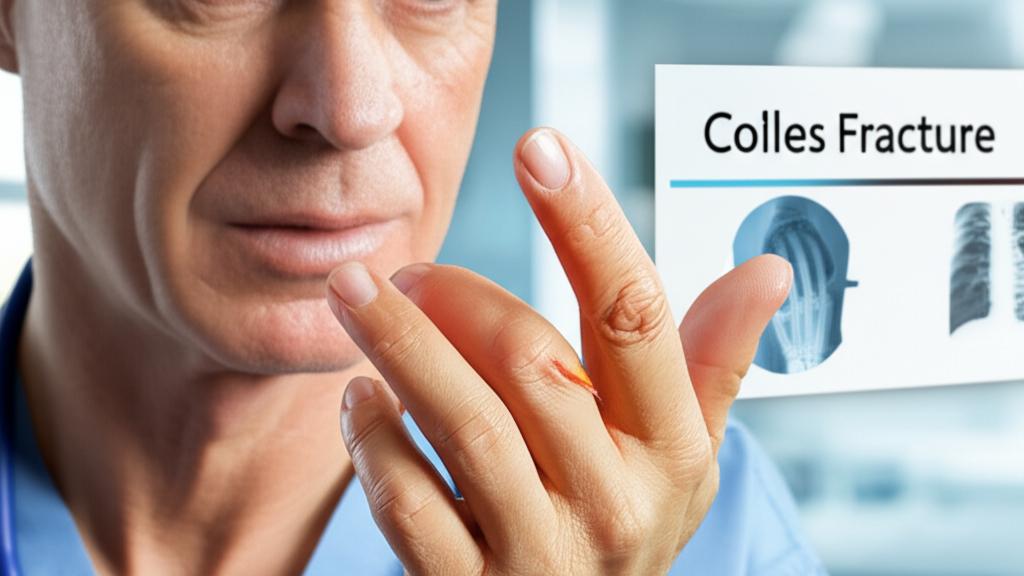It happens in a split second, doesn’t it? You trip, maybe over an unseen curb or a rug that’s decided to bunch up. Instinctively, your hand shoots out to break the fall. Then, that sickening crunch and a wave of intense pain in your wrist. If this sounds familiar, you might be dealing with something we see quite often in the clinic: a Colles fracture. It’s a very specific type of broken wrist, and honestly, it can be quite a jolt, both physically and emotionally.
So, what exactly is a Colles fracture? Let’s break it down.
Understanding Your Colles Fracture
When we talk about a Colles fracture, we’re referring to a break in the larger of the two forearm bones, called the radius, right near your wrist. Think about an inch from the end of the bone. The “Colles” part describes how the broken piece of bone tilts – specifically, it angles upwards, or dorsally, if we’re using the medical term. It’s named after Abraham Colles, the surgeon who first described it way back in 1814.
This usually happens, as I mentioned, when you fall onto an outstretched hand (we call this a FOOSH injury – Fall On OutStretched Hand). The force travels up your arm, and the distal end of your radius (that’s the part closest to your wrist) takes the hit and gives way.
Who’s Most at Risk?
While anyone can get a Colles fracture from a bad fall or trauma (like a car accident or a tumble during sports like skiing or biking), we do see it more often in certain groups.
- Older women, particularly those over 60 with osteoporosis, are especially prone. Osteoporosis is a condition where bones become weaker and more brittle. Sometimes, a fracture like this is the first sign that osteoporosis is present. It’s always a good idea to chat with your doctor about bone health, especially as we get older.
- Younger folks who are very active in sports can also experience this type of break.
It’s worth noting there’s another type of wrist fracture called a Smith fracture. It’s sometimes called a “reverse Colles fracture” because the broken bone piece angles downwards (volar angulation) instead of upwards.
What Might You Notice? Spotting the Signs
If you’ve unfortunately experienced a Colles fracture, the symptoms are usually pretty hard to ignore. You’ll likely feel:
- Sudden, severe pain in your wrist.
- Swelling around the wrist area, which can come on quickly.
- Bruising that develops.
- Your wrist might look obviously out of place, sometimes with a characteristic “dinner fork” deformity – where it looks bent at an odd angle.
- Tenderness to the touch.
- Difficulty moving or rotating your wrist or hand.
- Sometimes, numbness or tingling in your fingers if a nerve is affected.
Getting a Diagnosis: What We’ll Do
If you suspect you’ve broken your wrist, please don’t try to tough it out. Head to your nearest emergency department or urgent care. It’s a serious injury that needs proper attention.
When you come in, we’ll first want to hear what happened. How did you fall? What were you doing? Then, we’ll gently examine your wrist. The key to confirming a Colles fracture is an X-ray. This imaging test lets us see the bones clearly and understand the nature of the break – how displaced it is, and if any other bones are involved.
We might ask a few questions like:
- “Can you point to exactly where it hurts the most?”
- “Did you hear or feel a snap or pop?”
- “Have you had any previous wrist injuries?”
Fixing the Break: Treatment Options
The main goals of treating a Colles fracture are to put the broken bone back into its proper position and then keep it still so it can heal.
- Reduction (Setting the Bone): If the bone fragments are out of place (displaced), we’ll need to realign them. This is called a reduction. Sometimes, this can be done without surgery (a closed reduction), often with some pain relief or sedation to make you comfortable.
- Immobilization (Keeping it Still): Once the bone is aligned, we need to keep it from moving. This is usually done with a cast or a splint. The cast will typically go from below your elbow down to your fingers, holding your wrist steady. You’ll likely wear this for about six weeks, sometimes a bit longer. It’s super important to keep that cast dry!
- Surgery (When Needed): If the break is severe, unstable, or if the bones can’t be properly aligned with a closed reduction, surgery might be the best option. An orthopaedic surgeon (a doctor specializing in bone and joint problems) would perform this. During surgery, they might use:
After surgery, you’ll still likely have a cast for a period.
What About at Home?
While you’re waiting for medical attention, or after you’ve been treated, managing pain and swelling is key:
- Elevate your arm: Try to keep your wrist propped up above the level of your heart as much as possible, especially in the first few days. Pillows are your friend!
- Ice: Apply an ice pack wrapped in a thin towel for 15-20 minutes at a time, several times a day. Don’t put ice directly on your skin.
- Pain medication: Over-the-counter pain relievers like ibuprofen or acetaminophen can help. We’ll discuss what’s appropriate for you.
The Road to Recovery: Healing and Rehab
Healing takes time. Even after the cast comes off, your wrist will probably feel stiff and a bit weak. This is normal.
- Physical therapy is often a really important part of recovery. A physical therapist can guide you through specific exercises to help restore your wrist’s range of motion, strength, and function. These might include gentle stretching and then, later on, strengthening exercises.
- It can take several months, sometimes up to a year, for your wrist to feel completely back to normal, especially for more demanding activities. Patience is key.
Most people make a good recovery from a Colles fracture, but complications can sometimes occur, though they’re not the norm. These might include:
- Persistent stiffness
- Malunion (where the bone heals in a slightly off position)
- Nerve issues, like carpal tunnel syndrome (pressure on a nerve in the wrist causing numbness, tingling, or pain)
- Rarely, issues with tendons or the development of arthritis in the wrist later on.
We’ll monitor you for any of these.
Take-Home Message: Key Points on Colles Fracture
Alright, let’s quickly recap the most important bits about a Colles fracture:
- It’s a common break of the radius bone near your wrist, usually from falling on an outstretched hand.
- You’ll likely experience significant pain, swelling, and bruising, and your wrist may look deformed.
- Seek medical attention right away; X-rays are needed to diagnose it.
- Treatment involves setting the bone (reduction) and immobilizing it with a cast, though surgery is sometimes necessary for more complex breaks.
- Osteoporosis can be a contributing factor, especially in older women.
- Recovery involves time in a cast, followed by physical therapy to regain motion and strength. Be patient with the healing process.
A Final Thought
Dealing with an injury like a Colles fracture is never easy. It’s painful, it’s disruptive, and the recovery can feel long. But you’re not alone in this. We’re here to help you through the diagnosis, treatment, and rehabilitation. Follow the advice, do your exercises, and give your body the time it needs to heal. We’ll work together to get you back to using your wrist with confidence.


